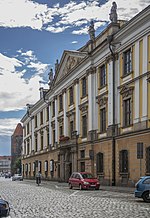Rzeszotary, Lower Silesian Voivodeship
Legnica County geography stubsVillages in Legnica County
Rzeszotary [ʐɛʂɔˈtarɨ] is a village in the administrative district of Gmina Miłkowice, within Legnica County, Lower Silesian Voivodeship, in south-western Poland. Prior to 1945, it was part of Germany. It lies approximately 7 kilometres (4 mi) east of Miłkowice, 4 km (2 mi) north of Legnica, and 64 km (40 mi) west of the regional capital Wrocław. The village has an approximate population of 960.
Excerpt from the Wikipedia article Rzeszotary, Lower Silesian Voivodeship (License: CC BY-SA 3.0, Authors).Rzeszotary, Lower Silesian Voivodeship
Wiejska, gmina Miłkowice
Geographical coordinates (GPS) Address Nearby Places Show on map
Geographical coordinates (GPS)
| Latitude | Longitude |
|---|---|
| N 51.25 ° | E 16.153611111111 ° |
Address
Wiejska 28
59-222 gmina Miłkowice
Lower Silesian Voivodeship, Poland
Open on Google Maps







